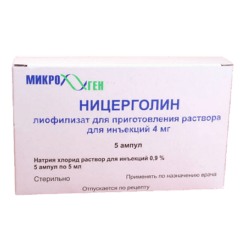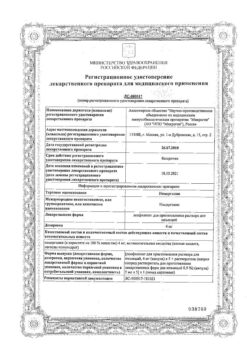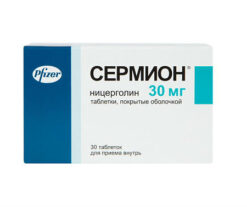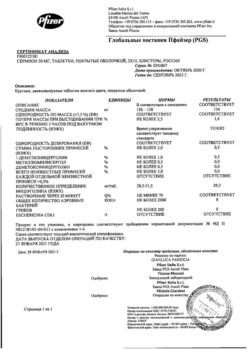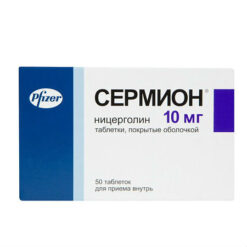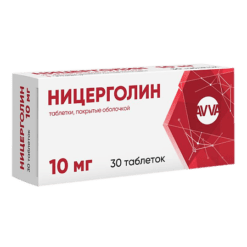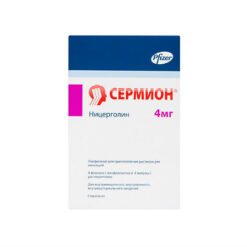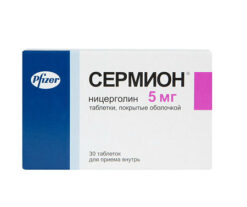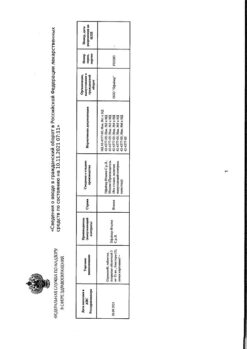No products in the cart.
Nitsergoline, lyophilizate 4 mg 35 mg 5 pcs
€1.00
Out of stock
(E-mail when Stock is available)
Description
Nicergoline is an alpha-adrenoblocking agent – a synthetic derivative of ergot alkaloids, with an attached bromosubstituted nicotinic acid residue. It has a vasodilator effect (including against the cerebral arteries). It improves microcirculation.
The contained residue of nicotinic acid has a direct myotropic spasmolytic effect on the muscular membrane of blood vessels, increases their permeability to glucose (leveling the opposite effect of the ergoline ring), which is most clearly seen in relation to the vessels of the brain and limbs. It improves cerebral, pulmonary and renal blood flow. It reduces the tone of the central vessels, increases arterial blood flow, increases oxygen and glucose delivery.
In therapeutic doses does not affect blood pressure; in patients with arterial hypertension it may cause a gradual moderate decrease in pressure. Reduces platelet aggregation and improves hemorheological parameters. It improves blood flow in the extremities, especially in circulatory insufficiency due to functional arteriopathies.
Pharmacokinetics
The bioavailability is about 60%. The maximum concentration is determined after 1-1.5 hours. 90% of the drug is metabolized by hydrolysis, demethylation and glucuronization to 1,6-dimethyl-8beta-oxymethyl-10alpha-methoxyergoline (1-MMDL), 1-hydroxymethyl-6-methyl-8beta-oxymethyl-10alpha-methoxyergoline (1-OHMMDL) and 6-methyl-8beta-oxymethyl-Ualpha-methoxyergoline (MDL – main active metabolite).
The kidneys excreted 70-80% of the drug and metabolites within 70-100 hours after administration. With the feces 20% of the drug is excreted. Period of half-life of the preparation is 2.5 hours, MDL – 12-17 hours, 1-MMDL – 2-4 hours.
Indications
Indications
Disorders of cerebral circulation (atherosclerosis of cerebral vessels, thrombosis and thromboembolism of cerebral arteries, post-traumatic encephalopathy, psychoorganic syndrome); vertigo, migraine;
peripheral circulatory disorders (organic and functional), arteriopathy of the extremities: obliterating endarteritis, Raynaud’s disease, diabetic angiopathy; dystrophic diseases of the cornea, diabetic retinopathy, ischemic optic neuropathy.
Pharmacological effect
Pharmacological effect
Nicergoline is an alpha-adrenergic blocking agent – a synthetic derivative of ergot alkaloids, with an attached bromo-substituted nicotinic acid residue. It has a vasodilating effect (including in relation to cerebral arteries). Improves microcirculation.
The contained nicotinic acid residue has a direct myotropic antispasmodic effect on the muscular lining of blood vessels, increases their permeability to glucose (neutralizing the opposite effect of the ergoline ring), which is most clearly manifested in the vessels of the brain and limbs. Improves cerebral, pulmonary and renal blood flow. Reduces the tone of central vessels, increases arterial blood flow, increases the delivery of oxygen and glucose.
In therapeutic doses it does not affect blood pressure; in patients with arterial hypertension it can cause a gradual moderate decrease in pressure. Reduces platelet aggregation and improves hemorheological parameters. Improves blood supply to the extremities, especially in cases of circulatory failure due to functional arteriopathy.
Pharmacokinetics
Bioavailability – about 60%. The maximum concentration is determined after 1-1.5 hours. 90% of the drug is metabolized by hydrolysis, demethylation and glucuronidation to 1,6-dimethyl-8beta-hydroxymethyl-10alpha-methoxyergoline (1-MMDL), 1-hydroxymethyl-6-methyl-8beta-hydroxymethyl-10alpha-methoxyergoline (1-OHMMDL) and 6-methyl-8beta-hydroxymethyl-alpha-methoxyergoline (MDL – the main active metabolite).
70-80% of the drug and metabolites are excreted by the kidneys within 70-100 hours after administration. 20% is excreted in feces. The half-life of the drug is 2.5 hours, MDL is 12-17 hours, 1-MMDL is 2-4 hours.
Active ingredient
Active ingredient
Nicergoline
Composition
Composition
Active ingredient: nicergoline 4 mg
Excipients:
tartaric acid – 1.04 mg;
lactose monohydrate (milk sugar) – 30 mg
Contraindications
Contraindications
Hypersensitivity, arterial hypotension, organic heart damage, myocardial infarction, angina pectoris, pregnancy, lactation.
Side Effects
Side Effects
Dyspepsia (nausea, vomiting, diarrhea, abdominal pain); hyperemia of the skin of the face and upper half of the body, fever, sleep disturbances, decreased blood pressure, headache, dizziness, angina pectoris, symptoms of ergotism;
coldness of the extremities, pain in the extremities; skin itching, allergic reactions.
Interaction
Interaction
Enhances the effects of antihypertensive drugs, anxiolytics and antipsychotics.
Antacids and cholestyramine slow down absorption.
Adrenergic stimulants, when used together, can cause idiosyncrasy.
Overdose
Overdose
Symptoms: increased severity of side effects, with the exception of allergic reactions.
Treatment: symptomatic therapy.
Storage conditions
Storage conditions
In a place protected from light, at a temperature of 2–10 °C.
Shelf life
Shelf life
3 years
Manufacturer
Manufacturer
Firm Enzyme LLC, Russia
Additional information
| Shelf life | 3 years |
|---|---|
| Conditions of storage | In a light-protected place at 2-10 °C. |
| Manufacturer | Firm Ferment, Russia |
| Medication form | lyophilizate |
| Brand | Firm Ferment |
Other forms…
Related products
Buy Nitsergoline, lyophilizate 4 mg 35 mg 5 pcs with delivery to USA, UK, Europe and over 120 other countries.


